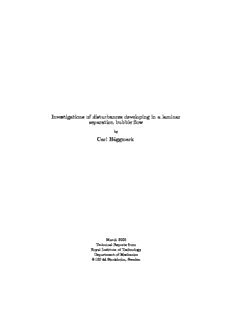
Investigations of disturbances developing in a laminar separation bubble flow Carl Häggmark PDF
Preview Investigations of disturbances developing in a laminar separation bubble flow Carl Häggmark
Investigations of disturbances developing in a laminar separation bubble flow by Carl Ha¨ggmark March 2000 Technical Reports from RoyalInstitute of Technology Department of Mechanics S-100 44 Stockholm, Sweden Akademisk avhandling som med tillst˚and av Kungliga Tekniska Ho¨gskolan i Stockholm framl¨agges till offentlig granskning fo¨r avla¨ggande av teknologie doktorsexamen fredagen den 31:e mars 2000kl 13.00iKollegiesalen, Adminis- trationsbyggnaden, KTH, Valhallava¨gen79,Stockholm. (cid:1)cCarl Ha¨ggmark 2000 H¨ogskoletryckeriet, Stockholm 2000 Till Jessica C. H¨aggmark 2000 Investigations of disturbances developing in a laminarsep- aration bubble flow Department of Mechanics, Royal Institute of Technology S-100 44 Stockholm,Sweden Abstract A separation bubble flow is considered in wind tunnel experiments. An exper- imental set-up is utilized in which steady two-dimensional laminar boundary- layer separation occurs on a flate plate due to an adverse pressure gradient. The pressure gradient is produced by a curved ceiling in the wind tunnel test section. In a low disturbance level environment, high frequency instability waves growintheseparatedshearlayer,whichreattachesandtransitiontoturbulence occurs. Detailed investigationsof the disturbance development are carried out using controlledforcingoflow-amplitudeinstabilitywaves. Their development andgrowthintheseparationbubbleflowisinvestigatedwithhot-wireanemom- etry, flow visualization technique and particle image velocimetry (PIV). Con- ventionalhot-wiremeasurementshavebeenperformedinthelaminarboundary layer upstream ofseparation, in the separated shear layer and in the reattach- ment zone. A region with exponential disturbance growth is observed in the separated shear layer associated with a highly two-dimensional flow. A local maximumin the disturbance amplitude develops at the inflection point in the mean velocity profile, indicating an inviscid type of instability. Further down- stream,inthereattachmentregion,acomplexthree-dimensionalflowstructure develops including reverse flow near the wall. Details of the flow field in this region have been obtained. A hot-wire technique, sensitive to the flow direction, has been developed for measurements of reverse flow near the wall. The operation of the direction sensitive probedonotdiffersignificantlyfromconventionalhot-wiretechnique. Measurements have been carried out with the probe inside the laminar sepa- ration bubble, providing informationon the reverse flow region. Finally,measurements ofthe meanflowanddisturbance growthhavebeen compared with direct numerical simulations. Descriptors: Laminarseparation bubbles, instabilitywaves, adverse pressure gradient,reverse flow,laminar-turbulenttransition,boundary-layerseparation, hot-wire anemometry, PIV, reattachment. Preface This thesis considers a laminarseparation bubble flowand disturbances devel- oping therein. It is based on the followingpapers: I Ha¨ggmark, C. P., Bakchinov, A. A. & Alfredsson, P. H. 2000 Experiments on a two-dimensional laminar separation bubble. Phil. Trans. R. Soc. Lond. A 358, (in press). II Ha¨ggmark, C. P., Bakchinov, A. A. & Alfredsson, P. H. 2000 Measurements with a flow direction boundary-layer probe in a two- dimensional laminarseparation bubble. Exp. in Fluids 28, (in press). III Ha¨ggmark, C. P. 2000 An experimental study of instabilitywaves in a laminarseparation bubble. IV Hildings, C., Ha¨ggmark, C. P. & Henningson, D. S. 2000 A numerical and experimental study of a transitional separation bubble. (submitted to Aerosp. Sci. Technol.). vii viii Contents Preface vii Chapter 1. Introduction 1 1.1. Aim and method 3 Chapter 2. Aspects of laminar separation bubble flows 4 2.1. Laminar separation bubbles in engineering flows 4 2.2. Classifications of separated flows 5 2.3. Experimental considerations 9 2.4. Bubble bursting 10 Chapter 3. Stability considerations 13 3.1. Basic flow equations 13 3.2. Inviscid linear stability theory - the Rayleighequation 15 3.3. Pressure gradients and separation 15 3.4. Secondary instabilityof wave disturbances 16 Chapter 4. Studies on laminar separation bubbles 18 4.1. Early work 18 4.2. Instability and transition 19 4.3. Development of three-dimensional disturbances 23 Chapter 5. Separation control 26 Chapter 6. Summary of Papers 31 Paper I 31 Paper II 31 Paper III 32 Paper IV 32 ix x CONTENTS Acknowledgments 34 References 35 I. Experiments on a two-dimensional laminar separation bubble 41 II. Measurements with a Flow Direction Boundary-Layer Probe in a Two-Dimensional Laminar Separation Bubble 61 III. An experimental study of instability waves in a laminar separation bubble 81 IV.Anumericalandexperimentalstudyofatransitionalseparation bubble 173
Description: